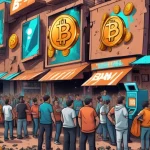Trump’s AI Surge vs. Tariff Woes: Can Bitcoin Save Small Businesses?

Trump’s AI Boom Clashes with Tariff Pain: Can Bitcoin and Blockchain Rescue Small Businesses?
A $350 billion AI investment surge is catapulting U.S. GDP and stock markets to dizzying heights in 2025, but beneath the tech glitter, small businesses and workers are getting crushed by Trump’s tariffs and soaring costs. This economic split—where trillion-dollar giants like Nvidia thrive while Main Street suffocates—raises tough questions about sustainability and fairness, and whether decentralized solutions like Bitcoin and blockchain can offer a lifeline to the underdog.
- AI Powerhouse: Tech investments drive 1.1% of U.S. GDP growth, outpacing consumer spending.
- Tariff Trauma: Trump’s trade policies inflate costs by $1.2 trillion globally, squeezing small businesses.
- Economic Rift: While tech dominates, manufacturing shrinks and consumer morale hits historic lows.
- Crypto Hope: Could Bitcoin and blockchain bypass centralized pain points for struggling firms?
AI’s Meteoric Rise: A Silicon Juggernaut
The U.S. economy is riding high on a wave of artificial intelligence investment, with tech giants leading a charge that’s rewriting the rules of growth. According to JPMorgan Chase, AI-related spending contributed 1.1% to GDP expansion in the first half of 2025—think of that as a massive boost to national output, fueling everything from job creation in tech hubs to skyrocketing corporate valuations. U.S. GDP growth clocked in at an impressive 3.8% in Q2 2025, recovering from a 0.5% dip in Q1, as reported by the Commerce Department. Leading the pack are eight mega-cap companies—Nvidia, Microsoft, Apple, Alphabet, Amazon, Meta, Tesla, and Broadcom—which together make up 37% of the S&P 500. Nvidia alone, valued at a staggering $4.5 trillion, accounts for 7% of the index and recently inked a $100 billion deal with OpenAI (now worth $500 billion) to power 10 gigawatts of systems. To put that in perspective, that’s enough juice to run roughly 8 million U.S. homes for a year—a colossal footprint for AI infrastructure.
But this isn’t just about smarter chatbots or cooler gadgets. It’s about raw computing power and data centers reshaping the economic landscape. Companies like Oracle and Advanced Micro Devices (AMD), the latter doubling its stock value in 2025 after partnering with OpenAI, are cashing in on this buildout. It’s a gold rush for Silicon Valley, no doubt, but the shine dims when you zoom out to see who’s left in the dust.
Small Business Survival: Tariffs as the Silent Killer
While Wall Street toasts to AI billions, small businesses are fighting for their lives under the weight of Trump’s trade policies. These tariffs—taxes slapped on imported goods to protect domestic industries—are projected by S&P Global to cost global businesses $1.2 trillion in 2025, with most of that burden trickling down to consumers through higher prices. Manufacturing has contracted for seven consecutive months, and construction costs are set to spike by 4.6% this quarter, per Cushman & Wakefield, largely due to these trade barriers. For the 25% of small business owners now in “survival mode” (as found by a KeyBank survey), representing 40% of U.S. GDP, this isn’t abstract policy—it’s a daily gut punch.
Consider Norton’s Florist in Birmingham, Alabama, a family business since 1921 that pulled in $4 million last year. Owner Cameron Pappas is being forced to shrink bouquet sizes just to avoid hiking prices as import costs for cut flowers from Colombia and Ecuador—where 80% of U.S. flowers come from—soar due to tariffs.
“If a bouquet has 25 stems in it, if you reduce that by three to four stems, then you’re able to keep the price the same. It’s really forced us to focus on that and to make sure that we’re pricing things the best that we possibly can,” Pappas said.
This isn’t just one shop’s struggle; it’s a microcosm of a broader crisis. Trump’s ‘America First’ stance might aim to boost local industry, but for many like Pappas, it feels more like ‘Small Business Last.’ And it’s not just florists—across sectors, owners are slashing offerings, renegotiating supply chains, or eating losses to keep customers from walking away.
Consumer Confidence Crumbles: A Holiday Chill
The pain ripples beyond storefronts to the average American’s wallet and mindset. A Deloitte survey reveals 57% of Americans expect the economy to weaken in 2026, marking the gloomiest outlook since 1997. This pessimism is showing up in holiday plans: Gen Z intends to spend 34% less, millennials 13% less, likely due to lingering inflation, stagnant wages, and uncertainty about the future. Seasonal retail hiring, often a bellwether for economic health, is at its lowest since 2009, according to Challenger, Gray & Christmas. When even corporate behemoths are slashing jobs—Target with 1,800 layoffs, Microsoft cutting 9,000, Starbucks axing 2,000 amid a $1 billion restructuring, and Salesforce trimming staff due to AI automation—it’s no wonder folks are tightening their belts.
This consumer retreat isn’t just a seasonal blip; it signals a deeper distrust in the system. Younger generations, especially, are caught between economic hardship and a tech-driven world that seems to benefit only the elite. Could this disillusionment push them toward alternative financial tools? More on that in a bit.
The Dark Side of AI: Boom or Bust?
Back to the AI juggernaut—while the numbers look rosy, there’s a nagging question about whether this is a house of cards. NYU Stern professor Arun Sundararajan offers a sobering take on the disparity between tech growth and the rest of the economy.
“I think the message that the AI economy is sort of driving up the GDP numbers is a correct one. There may be weakness in the rest of the economy, or not weakness, but there may be more modest growth,” Sundararajan noted.
He doesn’t stop there, pointing to a potential trap.
“Are we sort of inflating the economy now, thereby setting ourselves up for a crash in the future?”
It’s a fair jab. History echoes this concern—think of the dot-com bubble of the late ‘90s, where tech hype outpaced reality, leading to a brutal reckoning. Today’s AI boom risks a similar fate if it continues to prop up GDP while manufacturing tanks, small businesses bleed, and jobs vanish to automation. Even AI leaders like Microsoft and Salesforce are shedding staff to streamline operations, showing that tech’s golden age isn’t immune to cost-cutting. If the broader economy can’t keep pace, no amount of Nvidia stock gains will shore up a sinking Main Street. Acceleration is great, but without balance, it’s just a faster ride off the cliff.
Decentralized Dreams: Bitcoin and Blockchain as a Lifeline?
Here’s where we at Let’s Talk, Bitcoin see a spark of rebellion against this rigged game. Decentralization—the core ethos behind Bitcoin and blockchain technology—was born to challenge centralized power, whether it’s big banks or overreaching trade policies. Could these tools help small businesses dodge the tariff guillotine? Picture a florist like Norton’s sourcing flowers directly from South American growers, paying in Bitcoin to sidestep fiat conversion fees and bloated banking costs. No middlemen, no tariff-heavy import channels—just peer-to-peer trade. Blockchain platforms like VeChain or IBM’s Food Trust could also revolutionize supply chains, offering transparent, decentralized tracking of goods to cut reliance on costly intermediaries, letting small players punch above their weight.
Let’s break this down for the uninitiated. Bitcoin is a digital currency operating on a decentralized network, meaning no government or bank controls it—transactions happen directly between users. Blockchain is the underlying tech, a secure, tamper-proof ledger that records those transactions and can be used for everything from payments to tracking shipments. Decentralized finance, or DeFi, takes it further, building financial systems on blockchain without traditional institutions, potentially offering loans or trade financing to businesses shut out by banks.
But hold the champagne. Bitcoin’s infamous volatility—price swings of 10-20% in a week—can turn a smart trade into a disaster for a business on tight margins. Regulatory uncertainty is another beast; the U.S. government waffles on whether crypto is a currency, commodity, or contraband, creating a minefield for adoption. Plus, the learning curve is steep—most small business owners aren’t crypto OGs and might balk at setting up wallets or navigating DeFi platforms compared to, say, a familiar PayPal account. Still, when the system seems dead-set on crushing the little guy, Bitcoin’s promise of financial freedom hits harder than ever. If effective accelerationism means pushing tech to disrupt broken structures, then crypto is the underdog’s sharpest weapon—just one that needs serious sharpening.
Looking deeper, there’s a parallel between AI’s centralizing force and blockchain’s decentralizing counterpunch. AI infrastructure is largely controlled by trillion-dollar titans, concentrating economic power. Could blockchain enable decentralized AI systems—think tokenized computing resources or community-run data hubs—that empower smaller players instead of excluding them? It’s a long shot with tech and regulatory hurdles galore, but the idea aligns with our mission to disrupt the status quo. Bitcoin itself, as a hedge against economic volatility, might also appeal to businesses and consumers wary of inflation or policy whiplash, much like it did post-2008 financial crisis when distrust in centralized systems peaked.
A High-Wire Act: Balancing Acceleration and Equity
Stepping back, the U.S. economy in 2025 under Trump’s policy shadow is a tightrope walk. AI investment acts as a turbo engine, driving growth and innovation at a blistering pace. Yet tariffs and cost pressures are an anchor, dragging down small businesses, workers, and consumer morale. The disconnect between Silicon Valley’s windfalls and Main Street’s woes couldn’t be uglier—think of it as a feast for the few while the many scrape by. Add in the specter of an AI-fueled bubble, and you’ve got a system teetering on the edge.
Our take? Acceleration through tech like AI can be a force for good, but only if paired with mechanisms—like decentralized systems—that redistribute power rather than hoard it. Bitcoin and blockchain aren’t perfect fixes, not by a long shot, but they represent a mindset shift toward freedom and resilience that’s desperately needed when centralized policies keep screwing the underdog. The road ahead demands brutal honesty about these economic divides and bold bets on disruptive solutions. Because if this gap widens, no amount of GPU chips or stock spikes will stop the foundation from cracking. Let’s push forward, but let’s make damn sure it’s in a direction that doesn’t leave half the country behind.
- What’s powering U.S. GDP growth in 2025?
AI investments from tech giants like Nvidia and Microsoft, adding 1.1% to growth, are outstripping traditional engines like consumer spending. - How are Trump’s tariffs impacting small businesses?
They’re jacking up import costs by an estimated $1.2 trillion globally, forcing owners like Cameron Pappas of Norton’s Florist to shrink offerings or rethink sourcing to avoid price hikes. - Why is consumer confidence tanking into 2026?
With 57% predicting a weaker economy, holiday spending plummeting (Gen Z down 34%, millennials 13%), and seasonal hiring at a 2009 low, morale is historically bleak. - Is the AI boom sustainable or a setup for failure?
It’s driving growth now, but experts like Arun Sundararajan warn of over-inflation, risking a future crash as other sectors like manufacturing and small businesses lag behind. - Can Bitcoin and blockchain ease tariff pain for businesses?
Potentially, by enabling direct, low-fee payments and decentralized supply chains to bypass middlemen, though volatility and regulatory barriers pose significant challenges. - How might blockchain counterbalance AI’s centralizing effects?
By enabling decentralized AI systems or tokenized resources, blockchain could help smaller players access tech benefits, though scalability and regulation remain hurdles.



